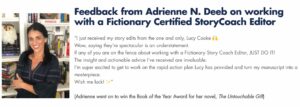
“Oh, great and powerful Muse of Literature,” you’ve undoubtedly cried at some ungodly hour. “Why does fiction editing have to be so… unruly? Can’t there be some magical tool? Some literary Excalibur that can help me wield my words into a tale that sings?”
All the while, your latest manuscript winks at you with the glee of a mischievous imp.
Well, dear writer, let me tell you, your prayers haven’t fallen on deaf ears. Once upon a time, I, too, was neck-deep in the sticky marshlands of editing. My manuscript was more tangled than a headphone cable. It felt like an impossible mission. A labyrinth with no end.
But then, like a literary lighthouse slicing through the fog, I discovered Fictionary.
Now, you might wonder, “What the Dickens is Fictionary?”
Well, I’m glad you asked.
Fictionary, my dear reader, is a tool specifically designed to assist writers with the daunting task of story editing. It leverages the 5 point story arc. This is a welcome breath of fresh air for those of us who found the conventional 8 point arc as bewildering as a Shakespearean sonnet written backward.
My encounter with Fictionary was nothing short of transformative. Suddenly, story editing wasn’t this terrifying beast with countless heads, but a manageable task.
And guess what? It can do the same for you. So, grab your riding hat and saddle up. We’re about to journey into the wonderful world of fiction editing, with Fictionary as our trusted steed.
Onward.
Your Editing a Novel Checklist: 5 Tips for Editing Fiction
Ah, editing. It’s the broccoli of the writing world.
Now, I like broccoli, but it’s not everyone’s favourite dish. But it’s essential for a well-balanced novel. It’s where you prune the unruly branches of your story tree. And where you ensure every leaf, twig, and berry serves a purpose. But, fret not. Here’s the first part of our trusty checklist to guide us through this vibrant adventure.
1. Edit for Character

Characters are the pulsating heart of your story. They are the driving force that propels your narrative vehicle down its winding road. Without well-drawn characters, your readers would hitchhike their way through a featureless landscape. So, let’s get to know our passengers, shall we?
POV Character
To start, identify your point-of-view (POV) character in each scene.
Now, this isn’t a onetime game of literary ‘Where’s Waldo,’ my dear writer. With each scene, ask yourself:
- Who is my POV Character in this scene?
- Is it clear to the reader this character is the POV in this scene?
- Does this scene deepen the reader’s understanding of the POV Character?
If you’re shaking your head, it’s time to wave your Fictionary wand and make the adjustments.
POV Goal
Every character, like you and me, has goals.
Whether it’s nabbing the last chocolate chip cookie or unmasking a dastardly villain, your POV character should have an obvious goal in each scene. And you should always design this goal to take the protagonist closer or further away from achieving their story goal.
Why? Because goals drive action, and action drives the plot. No goal means no gas in your story’s tank. And goals unrelated to plot are unnecessary.
What if the POV Character Goal Fails?:
This is where the real fun starts.
What happens if your POV character cannot achieve their goal? The answer should be tension, conflict, and stakes higher than a giraffe’s dinner plate. The possibility of failure should send a shiver down your character’s spine, pushing them to take risks and make hard choices.
Remember, a smooth sea never made a skilled sailor, and an easy path never made an exciting story.
And voila.
There we have it. The first step in our editing journey. Editing for character may seem like a daunting task. But with our Fictionary steed and our handy checklist, we’re more than equipped for the adventure ahead.
2. Edit for Plot

Think of the plot as the winding, often treacherous road that your characters (and readers) must traverse. It’s full of unexpected twists, towering peaks, and chilling valleys. Now, grab your Fictionary hiking boots, and let’s embark on this plot-editing expedition.
The Story Arc
Ah, the classic narrative arc.
From “Once upon a time…” to “… and they lived happily ever after (or not),” it’s the well-trodden path we all know and love.
But, when editing, ensure your story follows this journey:
- Inciting Incident: The event that disrupts the everyday world
- Plot Point 1: The protagonist engages in the story conflict
- The Midpoint: Where the protagonist becomes active because of higher stakes
- Plot Point 2: The protagonist’s lowest moment
- The Climax: The protagonist resolves the central story conflict
Want to know the best thing about the Fictionary Software? When you import your manuscript, it draws the Story Arc for you. You can see how closely your arc matches the recommended story arc common to most successful commercial fiction books.
Entry and Exit Hooks
Each scene is a mini-story, with its own beginning, middle, and end. And just like any good story, it should keep your reader engaged from start to finish.
That’s where entry and exit hooks come in.
At the start of a scene, you need an irresistible lure to reel your reader in. At the end? A tantalising teaser leaves them hungry for more. It’s like the literary version of a roller coaster ride, with enough thrill to keep your readers buckled in tight.
Tension and Conflict
What’s a road trip without a bit of drama?
In the world of fiction, tension and conflict are the roadblocks. The detours. The flat tires that keep your story from becoming a snooze-worthy Sunday drive.
You should have either tension or conflict (or both) in every scene. This maintains a sense of unpredictability that keeps readers on the edge of their seats. Remember, no reader ever said, “I love this book! Nothing happens…”
Editing for plot may seem like navigating a labyrinth, but fear not.
With our Fictionary compass and these tips, you’ll be threading your plot needle like a pro. So, strap in and enjoy the ride.
Next stop… setting.
3. Edit for Setting

Setting isn’t just where your story takes place.
It’s the foundation that supports your characters and plot. It adds depth, dimension, and, dare I say it, sets the mood (get it? Setting… sets the mood? Alright, I’ll see myself out).
Location and Emotional Impact
First, ask yourself this. Why did you choose this location? Each setting should have a purpose, influencing the characters’ actions and driving the plot.
A creepy, dilapidated house might evoke fear, causing your character to tread cautiously. A vibrant cityscape might inspire creativity, leading to unexpected solutions. Your settings should do more than simply exist.
They should make your readers feel something.
The Five Senses
Want to bring your settings to life?
Harness the power of sensory detail:
- What does the ocean air smell like?
- How does the gritty dirt feel beneath your protagonist’s feet?
- How does the apple tart taste?
Don’t just tell your readers about the setting, let them experience it. It’s like offering them a free ticket to a 5D cinema.
A cinema where they can feel, hear, see, smell, and even taste your world.
Weather
Good ol’ Mother Nature. She’s got a knack for setting the mood, hasn’t she?
A sunny day might symbolise hope, while a storm could foreshadow conflict. Or, if you’re feeling rebellious, flip the script. How about a tear-jerking breakup on a gorgeous spring day? Think of weather as an extension of your setting.
It should subtly influence the emotional tone of your scenes.
When fiction editing for setting, remember this:
Every. Detail. Matters.
It’s the background that frames your masterpiece. So go on, get those Fictionary brushes out and start painting your world with the hues of emotion, sensory detail, and weather patterns.
Let’s create worlds that readers can sink into, like a comfy reading chair.
4. Edit in Phases

Think of editing like eating a life-sized chocolate elephant… you can’t do it all at once. Hmmm. But I do like chocolate… terrible analogy aside, we need to break the editing process down. That’s where editing in phases comes in.
Editing in phases is like deconstructing that chocolate elephant into manageable chunks. First, the ears. Second, the trunk. And so on. Each phase focuses on a different aspect of your manuscript, allowing you to sharpen one element at a time without feeling overwhelmed.
Here’s how you can do it.
The Big Picture Edit
Start with a high-level edit, looking at the overall structure of your novel, ask yourself:
- Are the plot points in the right places?
- Do the characters’ goals align with their actions?
- Is the pacing consistent?
- Are the settings immersive, etc.?
These are the big-ticket items you need to nail down before you worry about misplaced commas.
Line Edit
Next, delve into the nitty-gritty of your sentences:
- Are you showing or telling?
- Are your metaphors as sparkly as a Stephenie Meyer vampire in sunlight?
- Is your dialogue snappier than a crocodile in a bad mood?
Copy Edit
Once you’re happy with the content, it’s time to smooth out the technical details. Check for:
- Grammar errors
- Punctuation mishaps
- Confusing sentence structures
- Consistency in style and formatting
This is the phase where you turn into the grammar police.
Proofreading
Finally, proofread for any last-minute typos or errors that might have slipped through the cracks. I recommend doing this after a good night’s sleep, or after consuming copious amounts of coffee.
Whichever floats your boat.
Remember, Rome wasn’t built in a day and neither was any brilliant novel.
So take your time, enjoy the process, and remember to keep a sense of humour. It’s just you, your manuscript, and a hypothetical life-sized chocolate elephant.
Happy editing.
5. Hire a Professional Editor
As writers, we’re multi-talented folk. We create characters, construct entire worlds, and breathe life into our stories.
We’re the superheroes of our fictional universes, and that’s no small feat. But, like any good caped-crusader, we sometimes need a sidekick. Enter: the professional editor. They’re the Robin to your Batman, the Wasp to your Antman, the… well, you get the idea.
Hiring a professional editor is one of the best decisions you can make for your manuscript, and here’s why.
The Importance of a Professional Editor
First, let’s talk about perspective.
When you’re knee-deep in your own story, it’s challenging to spot plot holes, character inconsistencies, or issues with pacing.
An editor provides a fresh pair of eyes, spotting potential pitfalls that you may have missed. They’re like your literary guardian angel, swooping in to save your manuscript from the perils of plot issues and dangling modifiers.
Second, professional editors know their stuff.
They’ve studied the craft of writing, they understand the industry, and they’ve read more books than a hungry bookworm in a library. They can help you refine your manuscript to a shine, ensuring it’s ready for publication.
Types of Fiction Editors
Editors come in different guises, each with their own special skills. Let’s break it down.
- Developmental editors focus on the big picture. They help with plot structure, character development, theme, and pacing. They’re like story architects, helping you build a sturdy narrative structure.
- Line editors get down to the nitty-gritty of your sentences, polishing your prose until it shines brighter than the North Star on a clear night. They help with word choice, sentence structure, and the rhythm of your writing.
- Copy editors are your grammar superheroes. They fly in to rescue your manuscript. They vanquish villainous punctuation errors, spelling mistakes, and grammatical misdemeanors.
- Proofreaders are the final gatekeepers. They check your manuscript for any last-minute typos or errors that might have escaped the earlier rounds of editing.
The Brilliance of Fictionary Certified StoryCoach Editors

Ah, the million-dollar question. Do you need an editor? No. You don’t need any old editor. You need an outstanding editor.
Let’s chat about Fictionary Certified StoryCoach Editors.
Think of them as Gandalf-like figures in the fiction editing world. Wizards of story editing. They take your manuscript and weave their magic, enriching your plot, characters, and setting. This isn’t a skim of the surface edit. They dive into the depths of your narrative, ensuring every chapter, character, and plot point shines with narrative brilliance.
“But what about grammar and spelling?” you ask.
Well, here’s the twist. Readers can overlook an errant comma, but a weak plot or dull characters? That’s a cardinal sin. That’s why Fictionary Certified StoryCoach Editors are so vital. They focus on your story’s heart–the story itself–guaranteeing it resonates with readers.
These wizards wield the mighty Fictionary software. It’s a tool that dissects your manuscript based on fundamental storytelling principles. It provides an accurate overview of your narrative, giving your StoryCoach Editor the tools they need to make your story shine.
Fictionary Certified StoryCoach Editors are your narrative’s lighthouse. They guide your story from good to exceptional.
They collaborate with you to craft a captivating, unforgettable narrative. With Fictionary, you’re investing in a storytelling partner. A narrative powerhouse. And ultimately, your success as a writer.

Editing Fiction FAQs

How Can I Edit Fiction Well?
Editing fiction well takes more than a keen eye for typos and grammar goofs.
It’s about digging into the very marrow of your story and smoothing out any bumps that could trip your reader. It’s about ensuring your characters are real, your plot is tight, and your settings transport readers into your story world.
Remember the five tips I’ve provided and don’t rush.
Take your time to weigh each aspect. And while you’re at it, try to enjoy the process. After all, editing is where your story really comes to life.
What Are the Common Mistakes When Fiction Editing?
Even seasoned authors can stumble into pitfalls when fiction editing. Some of the common mistakes include:
- Rushing the process
- Editing while still in the writing mindset
- overlooking key story aspects such as character, plot, and setting
It’s also common to neglect the reader’s perspective. Remember, you know your story inside out… but your readers don’t.
Another faux pas?
Trying to edit your entire novel in one go. It’s overwhelming and can lead to sloppy editing. Instead, break it down and focus on one element at a time. And, of course, don’t forget to use tools like Fictionary to help.
How Can I Get the Most Out of These Five Tips?
To extract the maximum juice out of these five tips, apply them one at a time.
Don’t tackle everything at once. Editing is a layered process. Start with character editing. Then move to plot. Then move on to the setting. Edit in phases, giving each stage the focus it deserves.
Don’t rush. Let the insights from each phase marinate before moving on to the next.
Remember to approach editing with the mindset of a reader, not just an author.
And finally, don’t underestimate the power of professional editing. A Fictionary Certified StoryCoach Editor can provide a level of feedback that’s hard to match.

Conclusion: Fiction Editing
As we draw the curtain on our fiction editing exploration, remember, this need not be an intimidating trek. With a well-structured plan, consistent efforts, and the Fictionary software, you’re well prepared for triumph.
Do not overlook the power of in-depth character, plot, and setting editing.
Nor the crucial role played by meticulous grammar and punctuation. It’s about weaving a narrative that’s gripping, balanced, and enthralling.
The Fictionary software is more than just a digital tool.
It penetrates the heart of your narrative, ensuring its pulse is dynamic and uniform. Think of it as your story’s personal fitness trainer, tuning it for the marathon of publishing. Fictionary is more than an accessory.
It’s your companion on this literary expedition, bearing the technical weight of storytelling and propelling your narrative towards its peak potential.
Remember, you craft a compelling tale word by word, draft after draft.
Harness these tips, lean on the Fictionary software, and stride boldly forward on your narrative journey. Every story deserves to shine, especially yours. Now, off you go to create your literary masterpiece.
Article Written by Shane Millar

Shane Millar is a Fictionary Certified Story Coach and the author of the Write Better Fiction craft guides. He is also the author of the Myth & Magic and Chosen Vampire urban fantasy thriller series.
Shane holds a BA in journalism and is a member of The Alliance of Independent Authors (ALLi). He lives in Buckinghamshire, England.
He has taken too many writing courses to count and enjoys reading as much as possible. Shane is obsessed with five things: the writing craft, mythology, personal development, food, and martial arts movies.
Want to hire Shane to edit your novel? Visit: https://swmillar.com/editing


